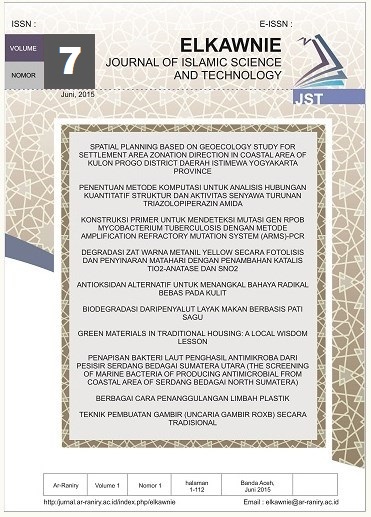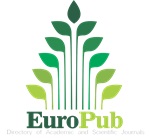Mineralogical, Microstructural and Compressive Strength Characterization of Fly Ash as Materials in Geopolymer Cement
DOI:
https://doi.org/10.22373/ekw.v7i1.7787Keywords:
geopolymer, fly ash, epoxy, cement, compressive strengthAbstract
Abstract: This study was designed to examine the mineral, microstructural, and mechanical strength properties of fly ash and its feasibility as a raw material for geopolymer cement. The study used an experimental method by examining the characteristics of fly ash by X-ray Fluorescence Spectrometer (XRF), Fourier transform infrared (FTIR) spectroscopy, X-ray diffraction (XRD), hydrometer method, Scanning electron microscopy (SEM), and compressive strength testing. For creating the geopolymer cement paste, a concentration of NaOH 10M was used, with a ratio of water/solid = 0.4 and a ratio of Na2SiO3/NaOH = 1 using curring at room temperature. The results showed the geopolymer pastes have a compressive strength of 18.1 MPa and 21.5 MPa after 7 days and 28 days. The XRD results showed a decrease in the peak of 2θ at 26.54° because the amorphous part had transformed into a C-S-H solution in geopolymer cement. This finding was supported by the FTIR spectra results showing Si-O-Si bending vibration and the functional group of AlO2. It showed that Nagan Raya fly ash-based geopolymer is a potential construction material.
Abstrak: Penelitian ini dirancang untuk mendapatkan sifat mineral, mikrostruktural, dan kekuatan mekanis dari fly ash serta kesesuaiannya sebagai material dasar pada semen geopolimer. Metode penelitian yang digunakan adalah metode eksperimen dengan cara menguji karakteristik dari fly ash dengan pengujian X-ray Fluorescense Spectrometer (XRF), Fourier transform infrared (FTIR) spectoscopy, X-ray diffraction (XRD), hydrometer method, Scanning electron microscopy (SEM) dan kuat tekan. Untuk pembuatan pasta semen geopolimer digunakan konsentrasi NaOH 10 M, rasio water/solid 0,4 dan rasio Na2SiO3/NaOH = 1 dengan perawatan pada suhu kamar. Hasil menunjukkan setelah 7 hari pasta geopolimer memiliki kuat tekan 18,1 MPa dan 21,5 MPa pada 28 hari. Hasil XRD menunjukkan adanya penurunan puncak 2θ pada 26,54° ini disebabkan karena bagian amorf dari fly ash telah menjadi larutan C-S-H pada semen geopolimer. Hasil ini diperkuat dengan analisis FTIR spectra yang menunjukkan adanya Si-O-Si bending vibration dan gugus fungsi dari AlO2. Hasil menunjukkan fly ash dari Nagan Raya potensial sebagai bahan material konstruksi berbasis geopolimer.
References
Agrawal, U., Wanjari, S., & Naresh, D. (2019). Impact of replacement of natural river sand with geopolymer fly ash sand on hardened properties of concrete. Construction and Building Materials, 209. https://doi.org/https://doi.org/10.1016/j.conbuildmat.2019.03.134
Aouan, B., Alehyen, S., Fadil, M., Alouani, M. EL, Khabbazi, A., Atbir, A., & Taibi, M. (2021). Compressive strength optimization of metakaolin‐based geopolymer by central composite design. Chemical Data Collections, 31, 100636. https://doi.org/https://doi.org/10.1016/j.cdc.2020.100636
Arioz, E., Arioz, O., & Kockar, O. M. (2020). Geopolymer Synthesis with Low Sodium Hydroxide Concentration. Iranian Journal of Science and Technology, Transactions of Civil Engineering, 44, 525–533. https://doi.org/https://doi.org/10.1007/s40996-019-00336-1
Azevedo, A. G. S., Strecker, K., Barros, L. A., Tonholo, L. F., & Lombardi, C. T. (2019). Effect of Curing Temperature, Activator Solution Composition and Particle Size in Brazilian Fly-Ash Based Geopolymer Production. Materials Research, 22. https://doi.org/https://doi.org/10.1590/1980-5373-mr-2018-0842
Chindaprasirt, P., Homwuttiwong, S., & Sirivivatnanon, V. (2004). Influence of fly ash fineness on strength, drying shrinkage and sulfate resistance of blended cement mortar. Cement and Concrete Research, 34(7), 1087–1092. https://doi.org/10.1016/j.cemconres.2003.11.021
Chung, F. H. (1974). Quantitative Interpretation of X-ray Diffraction Patterns of Mixtures. I1. Adiabatic Principle of X-ray Diffraction Analysis of Mixtures. J. Appl. Crystallogr, 7, 526–530.
Da Luz, G., Gleize, P. J. P., Batiston, E. R., & Pelisser, F. (2019). Effect of pristine and functionalized carbon nanotubes on microstructural, rheological, and mechanical behaviors of metakaolin-based geopolymer. Cement and Concrete Composites, 104(July 2018), 103332. https://doi.org/10.1016/j.cemconcomp.2019.05.015
Diaz, .I., Allouche, E. N., & Eklund, S. (2010). Factors affecting the suitability of fly ash as source material for geopolymers. Fuel, 89(5), 992–996. https://doi.org/https://doi.org/10.1016/j.fuel.2009.09.012
Du, J., Bu, Y., Shen, Z., Hou, X., & Huang, C. (2016). Effects of epoxy resin on the mechanical performance and thickening properties of geopolymer cured at low temperature. Materials and Design, 109, 133–145. https://doi.org/10.1016/j.matdes.2016.07.003
Erfanimanesh, A., & Sharbatdar, M. K. (2020). Mechanical and microstructural characteristics of geopolymer paste, mortar, and concrete containing local zeolite and slag activated by sodium carbonate. Journal of Building Engineering, 32, 101781. https://doi.org/https://doi.org/10.1016/j.jobe.2020.101781
Ferone, C., Roviello, G., Colangelo, F., Cioffi, R., & Tarallo, O. (2013). Novel hybrid organic-geopolymer materials. Applied Clay Science, 73(1), 42–50. https://doi.org/10.1016/j.clay.2012.11.001
Fuller, A., Maier, J., Karampinis, E., Kalivodova, J., Grammelis, P., Kakaras, E., & Scheffknecht, G. (2018). Fly Ash Formation and Characteristics from (co-)Combustion of an Herbaceous Biomass and a Greek Lignite (Low-Rank Coal) in a Pulverized Fuel Pilot-Scale Test Facility. Energies, 11(6), 1–38. https://doi.org/https://doi.org/10.3390/en11061581
Gharzouni, A., Vidal, L., Essaidi, N., Joussein, E., & Rossignol, S. (2016). Recycling of geopolymer waste: Influence on geopolymer formation and mechanical properties. Materials & Design, 94, 221–229. https://doi.org/https://doi.org/10.1016/j.matdes.2016.01.043
Gouny, F., Fouchal, F., Maillard, P., & Rossignol, S. (2012). A geopolymer mortar for wood and earth structures. Construction and Building Materials, 36, 188–195. https://doi.org/https://doi.org/10.1016/j.conbuildmat.2012.04.009
Guo, X., Shi, H., Chen, L., & Dick, W. A. (2010). Alkali-activated complex binders from class C fly ash and Ca-containing admixtures. Journal of Hazardous Materials, 173(1), 480–486. https://doi.org/https://doi.org/10.1016/j.jhazmat.2009.08.110
Itskos, G., Itskos, S., & Koukouzas, N. (2010). Size fraction characterization of highly-calcareous fly ash. Fuel Processing Technology, 91(11), 1558–1563. https://doi.org/https://doi.org/10.1016/j.fuproc.2010.06.002
Jose, A., Nivitha, M. R., Krishnan, J. M., & Robinson, R. G. (2020). Characterization of cement stabilized pond ash using FTIR spectroscopy. Construction and Building Materials, 263(10), 120136. https://doi.org/https://doi.org/10.1016/j.conbuildmat.2020.120136
Komnitsas, K., Zaharaki, D., & Perdikatsis, V. (2007). Geopolymerisation of low calcium ferronickel slags. J Mater Sci, 42, 3073–3082. https://doi.org/10.1007/s10853-006-0529-2
Kovalchuk, G., Jiménez, A. F., & Palomo, A. (2008). Alkali-activated fly ash. Relationship between mechanical strength gains and initial ash chemistry. Materiales de Construcción, 58(291), 35–52. https://doi.org/https://doi.org/10.3989/mc.2008.v58.i291.101
Lahoti, M., Wong, K. K., Tan, K. H., & Yang, E.-H. (2018). Effect of alkali cation type on strength endurance of fly ash geopolymers subject to high temperature exposure. Materials & Design, 154, 8–19. https://doi.org/https://doi.org/10.1016/j.matdes.2018.05.023
Leong, H. Y., Ong, D. E. L., Sanjayan, J. G., & Nazari, A. (2016). Suitability of Sarawak and Gladstone fly ash to produce geopolymers: A physical, chemical, mechanical, mineralogical and microstructural analysis. Ceramics International, 42(8), 9613–9620. https://doi.org/10.1016/j.ceramint.2016.03.046
Lynn, C. J., OBE, R. K. D., & Ghataora, G. S. (2016). Municipal incinerated bottom ash characteristics and potential for use as aggregate in concrete. Construction and Building Materials, 127(30), 504–517. https://doi.org/https://doi.org/10.1016/j.conbuildmat.2016.09.132
Mohammed, B. S., Haruna, S., Wahab, M. M. A., Liew, M. S., & Haruna, A. (2019). Mechanical and microstructural properties of high calcium fly ash one-part geopolymer cement made with granular activator. Heliyon, 5(9), e02255. https://doi.org/https://doi.org/10.1016/j.heliyon.2019.e02255
Peyne, J., Gautron, J., Doudeau, J., Joussein, E., & Rossignol, S. (2017). Influence of calcium addition on calcined brick clay based geopolymers: A thermal and FTIR spectroscopy study. Construction and Building Materials, 152(15), 794–803. https://doi.org/https://doi.org/10.1016/j.conbuildmat.2017.07.047
Phoo-ngernkham, T., Chindaprasirt, P., Sata, V., Hanjitsuwan, S., & Hatanaka, S. (2014). The effect of adding nano-SiO2 and nano-Al2O3 on properties of high calcium fly ash geopolymer cured at ambient temperature. Materials and Design, 55, 58–65. https://doi.org/10.1016/j.matdes.2013.09.049
Ranjbar, N., Mehrali, M., Behnia, A., Alengaram, U. J., & Jumaat, M. Z. (2014). Compressive strength and microstructural analysis of fly ash/palm oil fuel ash based geopolymer mortar. Materials & Design, 59, 532–539. https://doi.org/https://doi.org/10.1016/j.matdes.2014.03.037
Rattanasak, U., Pankhet, K., & Chindaprasirt, P. (2011). Effect of chemical admixtures on properties of high-calcium fly ash geopolymer. International Journal of Minerals, Metallurgy, and Materials, 18(3), 364. https://doi.org/https://doi.org/10.1007/s12613-011-0448-3
Ryu, G. S., Lee, Y. B., Koh, K. T., & Chung, Y. S. (2013). The mechanical properties of fly ash-based geopolymer concrete with alkaline activators. Construction and Building Materials, 47, 409–418. https://doi.org/DOI: 10.1016/j.conbuildmat.2013.05.069
Saidi, T., & Hasan, M. (2020). The effect of partial replacement of cement with diatomaceous earth (DE) on the compressive strength and absorption of mortar. Journal of King Saud University - Engineering Sciences. https://doi.org/10.1016/j.jksues.2020.10.003
Sarkar, M., & Dana, K. (2021). Partial replacement of metakaolin with red ceramic waste in geopolymer. Ceramics International, 47(3). https://doi.org/https://doi.org/10.1016/j.ceramint.2020.09.191
Sutan, N. M., Yakub, I., & Hamdan, S. (2014). Physico characterization of polymer composite cement systems. In High Performance and Optimum Design of Structures and Materials (p. 103). WITPress.
Temuujin, J., Minjigmaa, A., Davaabal, B., Bayarzul, U., Ankhtuya, A., Jadambaa, T., & MacKenzie, K. J. D. (2014). Utilization of radioactive high-calcium Mongolian flyash for the preparation of alkali-activated geopolymers for safe use as construction materials. Ceramics International, 40(10), 16475–16483. https://doi.org/https://doi.org/10.1016/j.ceramint.2014.07.157
Tho-in, T., Sata, V., Chindaprasirt, P., & Jaturapitakkul, C. (2012). Pervious high-calcium fly ash geopolymer concrete. Construction and Building Materials, 30, 366–371. https://doi.org/https://doi.org/10.1016/j.conbuildmat.2011.12.028
Troëdec, M., Peyratout, C. S., Smith, A., & Chotard, T. (2009). Influence of various chemical treatments on the interactions between hemp fibres and a lime matrix. Journal of the European Ceramic Society, 29(10), 1861–1868. https://doi.org/https://doi.org/10.1016/j.jeurceramsoc.2008.11.016
Wattimena, O. K., Antoni, A., & Hardjito, D. (2017). A review on the effect of fly ash characteristics and their variations on the synthesis of fly ash based geopolymer. AIP Conference Proceeding, 1887, 020041. https://doi.org/http://dx.doi.org/10.1063/1.5003524
Wilińska, I., & Pacewska, B. (2018). Influence of selected activating methods on hydration processes of mixtures containing high and very high amount of fly ash. Journal of Thermal Analysis and Calorimetry, 133, 823–843. https://doi.org/https://doi.org/10.1007/s10973-017-6915-y
Downloads
Published
Issue
Section
License
Proposed Policy for Journals That Offer Open Access Authors who publish with the Elkawnie journal agree to the following terms:
a. Authors retain copyright and grant the journal right of first publication with the work simultaneously licensed under a Creative Commons Attribution License that allows others to share the work with an acknowledgement of the work's authorship and initial publication in this journal.
b. Authors are able to enter into separate, additional contractual arrangements for the non-exclusive distribution of the journal's published version of the work (e.g., post it to an institutional repository or publish it in a book), with an acknowledgement of its initial publication in this journal.
c. Authors are permitted and encouraged to post their work online (e.g., in institutional repositories or on their website) prior to and during the submission process, as it can lead to productive exchanges, as well as earlier and greater citation of published work (see The Effect of Open Access).

























